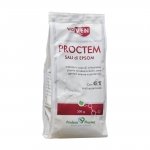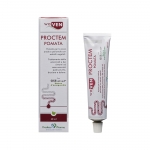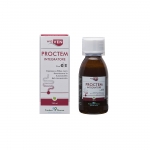Ours is a holistic approach that does not hinder the physiological processes of the body. It's an approach that encourages the restoration of balance, by combatting the causes of symptoms as efficiently as possible and ensuring fast relief.
Symptoms and relief
SELECT YOUR NEED

Venous system
VENOUS INSUFFICIENCY AND VARICOSE VEINS
WHAT IS IT?
Chronic venous insufficiency is a circulatory disorder that causes a slowing of the blood flow from the extremities to the heart, resulting in the "stagnation" of blood in the veins. The most affected areas are:
- THE VEINS IN THE LOWER LIMBS, with the development of varices (permanent dilations of the vein wall, commonly called "varicose veins");
- THE VEINS IN THE HEMORROID PLEXUS, with the development of hemorrhoids (due to increased venous pressures during defecation, especially in cases of constipation);
- THE GENITAL VEINS, with the development of varicoceles ("scrotal" in men and "pelvic" in women).
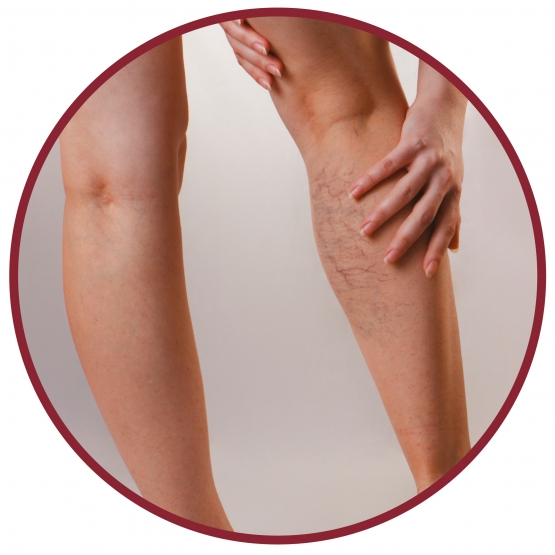
This issue is widespread, especially among women. The current prevalence of varicose veins in the lower extremities is 10-50% in the adult male population and 50-55% in the female population. Varicose disease occurs in 10-33% of females and 10-20% of adult males.
Venous insufficiency manifests itself through LOWER LIMB SYMPTOMS, such as:
- a feeling of tiredness and heaviness in the legs;
- pain and discomfort in a standing, static and prolonged posture;
- altered sensitivity (tingling, itching, a burning sensation and the sensation of warmth);
- night pains and cramps (the so-called "restless leg syndrome");
- skin dyschromia (pigmentations in the ankles and/or feet);
- visible capillaries;
- varicose veins;
- swelling of the legs and ankles;
- alterations of the skin and skin ulcers.
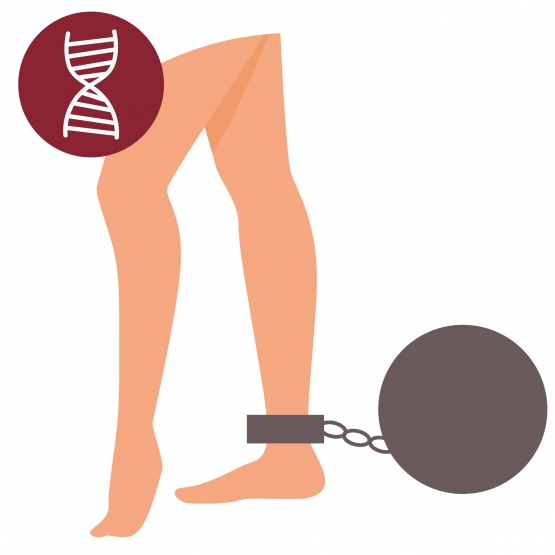
CAUSES
The causes may be "organic" or "functional," depending on whether the veins are impaired or overactive. In general, venous insufficiency is common in individuals who:
- suffer from chronic constipation;
- are overweight;
- do not engage in adequate physical activity;
- suffer from water retention;
- maintain an incorrect posture;
- suffer from hormonal imbalances (e.g., pregnancy, oral contraception, etc.);
- are exposed to heat on a prolonged basis (e.g., heating, sun exposure, etc.);
- have a family predisposition (congenital weakness of the veins);
- have undergone a traumatic event (which caused an alteration of the muscle pump).
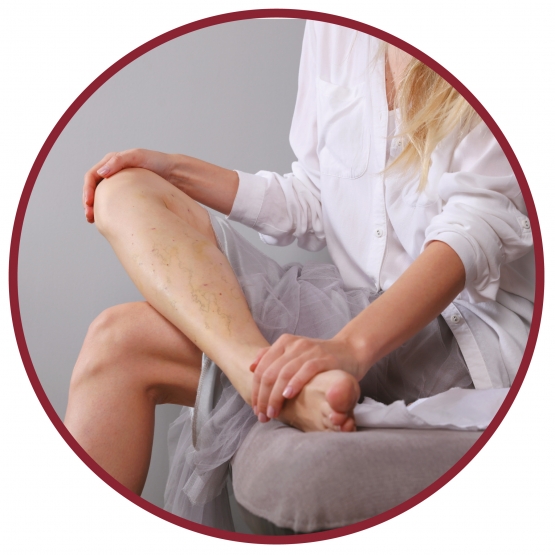
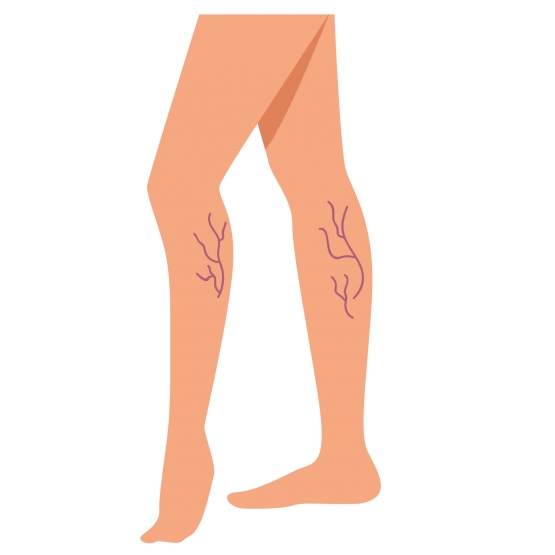
A DEGENERATIVE ISSUE
This dysfunction is often underestimated or connected to a mere cosmetic issue. In reality, venous insufficiency is a degenerative and evolving condition which, if not properly treated, exposes the patient to a number of complications, including deep vein thrombosis and pulmonary embolism.
One particular element of concern is the level of homocysteine in the blood. If present at high concentrations, this amino acid can alter the functioning of vascular cells and favor the occurrence of thrombi, promoting the development of complications of chronic venous disease.
In severe cases, pharmacological and surgical interventions are required.
HEMORRHOIDS
Hemorrhoids represent one of the most frequent diseases of the lower gastrointestinal system, favored by the decreased consumption of fiber in the modern diet, the abuse of processed foods and medications, a sedentary lifestyle, etc.
Although a common issue for both sexes, hemorrhoids occur more often
in the female population; the causes of this predisposition include pregnancies, hormonal changes related to the menstrual cycle and an increased tendency towards varicose veins.

WHAT ARE THEY?
Hemorrhoids (from the Greek "aima" = blood, "reo" = to flow, meaning "bleeding") are defined as "hemorrhoid plexus ectasia": that is, the pathological varicose dilatation of the arteriovenous-venous area, called "hemorrhoid plexuses," located in the distal part of the rectum. The hemorrhoid plexuses provide, together with the sphincter, the evacuation and continence functions of the anus and are differentiated into "internal submucosal plexus" and "external subcutaneous plexus," anatomically connected with each other.
These plexuses communicate below the mucosa of the anal canal and have, in addition to capillaries, numerous arteriovenous anastomoses, which account for the arterial bleeding of some hemorrhoids.
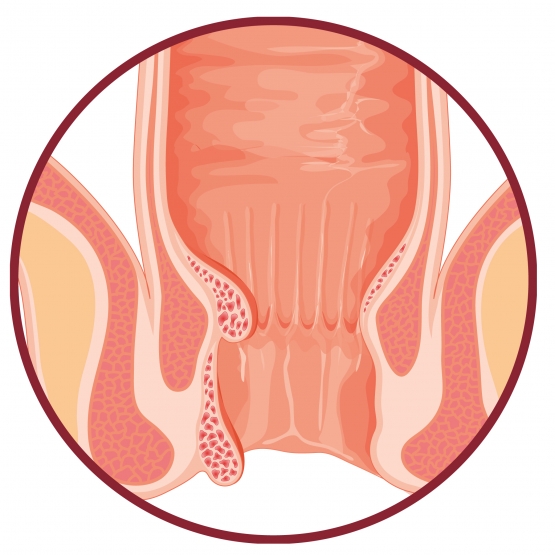
Hemorrhoidal disease is characterized by blood vessels that dilate irregularly, triggering the formation of varices. This can result in prolapse (exit of the hemorrhoid plexuses from the anal sphincter), thrombosis (formation of painful bluish nodules) and bleeding (when the dilated and thinned venous wall ruptures). Because of the high amount of nerves present in this anatomical area, this pathology can be very painful.
A disorder of increasing severity
Depending on the stage of the disorder, they are differentiated into:
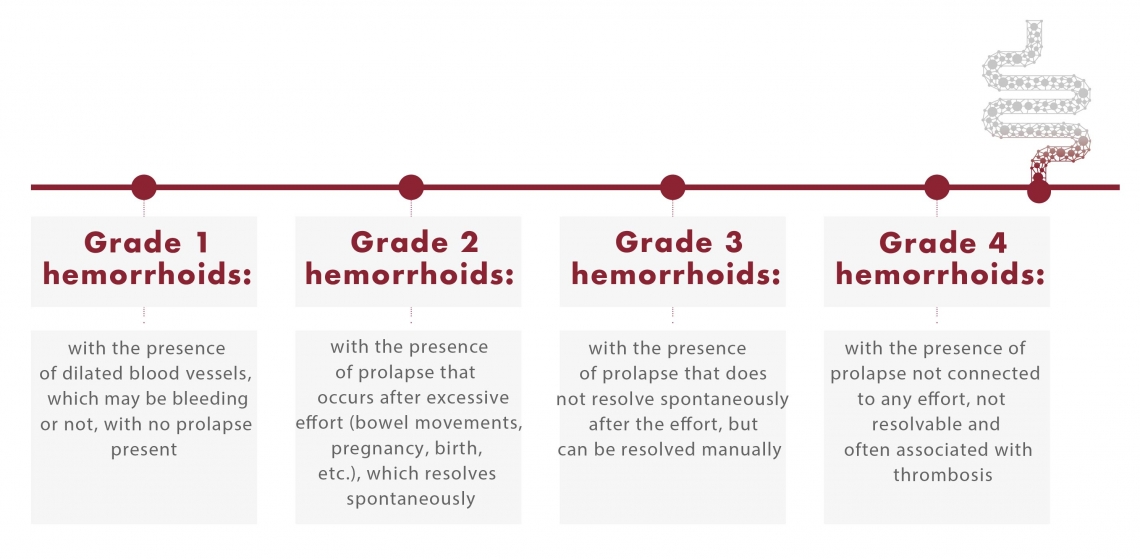
Progression occurs because the tissues supporting and containing the vessels stretch, the veins dilate and their walls become thinner and bleed. If tension and pressure continue to be present, the weakened veins prolapse.
PREDISPOSING FACTORS
- hereditary predisposition, characterized by weakness of the venous walls and a tendency towards varicose vein formation in other body areas as well
- chronic constipation, often associated with a low-fiber diet
- standing or sitting too long, which can cause a state of increased pressure in the anal veins, either due to gravity or to difficult venous drainage
- certain sports (such as horseback riding, motorcycling or cycling) can cause the support structures of the anal canal to weaken in the long run, exposing one to the risk of hemorrhoids
- spicy foods, cocoa, alcohol and pork, as they irritate and set off venous dilation, acting as triggering factors
- in women, increased pelvic pressure, especially during pregnancy, but also at certain times during the menstrual cycle
- aging
- obesity

A DISORDER OF INCREASING SEVERITY
Acute hemorrhoidal crisis manifests with stinging pain and the sensation of a foreign body at the anal orifice. It occurs when hemorrhoidal thrombosis (bluish swellings of hard consistency) is present, which generally prolapses, aggravated by the contraction of the anal sphincter.
Hemorrhoidal thrombosis can occur frequently in patients with hemorrhoidal disease, usually triggered by physical stress or dietary "mistakes," alternating with latent phases in which the subject is living with the symptoms but has not resolved them.

For the venous system
HORSE CHESTNUT
Horse chestnut seeds contain a mixture of saponins called "escin" which has vasoprotective, vasokinetic and antiedematous effect: it decreases small vessel permeability and improves venous tone, reducing edema and swelling. Anti-inflammatory, antioxidant and antihemorrhoidal properties have also been demonstrated.
INDIAN PENNYWORT
Indian Pennywort is a plant that has been used for centuries in traditional Chinese medicine for its anti-inflammatory and age-protective properties. Due to the presence of triterpenes, it promotes microcirculation function, relieving the feeling of heaviness in the legs, and also has a vasotonic and antioxidant function.
BUTCHER'S BROOM
Butcher's Broom extract has an anti-inflammatory effect and improves venous circulation through increased pumping activity. Clinical studies have shown that its consumption leads to a marked regression of symptoms (such as itching, tightness and cramping) and a decrease in ankle circumference, thanks to an effective reduction in swelling.
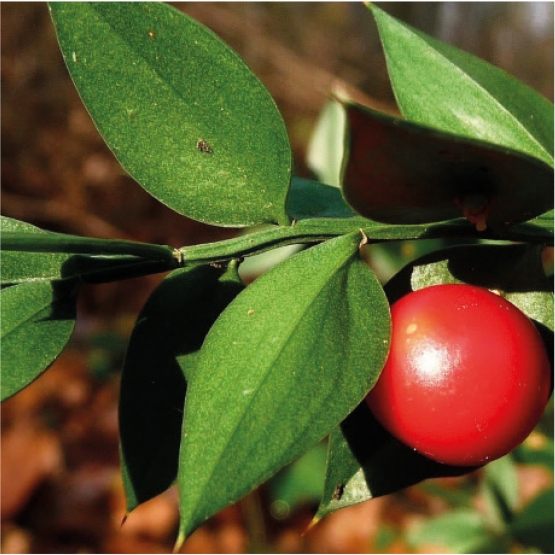
SWEET YELLOW CLOVER
Sweet Yellow Clover is an aromatic plant that has shown useful properties for the treatment of varicose veins, hemorrhoids and venous thrombosis, acting as an anticoagulant, draining agent, astringent and emollient. It improves the symptoms of heavy legs, pain, night cramps, edema and itching, and also promotes the drainage of bodily fluids.
WHITE GRAPEVINE
The effects of Grapevine at the vascular level have been known for a long time. It supports the microcirculation function, alleviating the feeling of heaviness in the legs, and promotes the regular function of the cardiovascular system. In addition, the oligomeric procyanidins (OPCs) found in its seeds, have been shown to have powerful antioxidant properties.
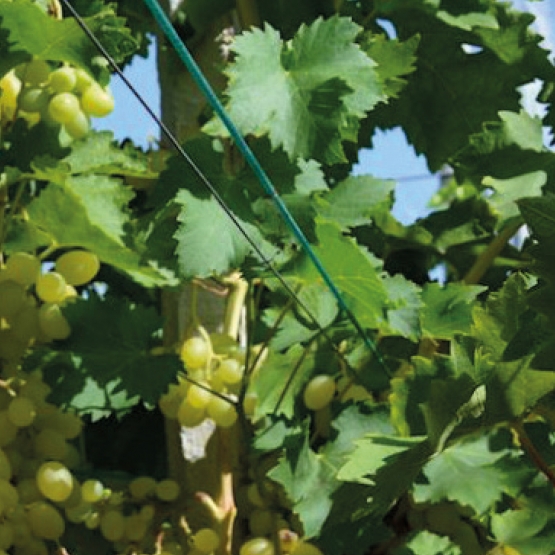
CHLORELLA
Chlorella vulgaris is a single-celled microalga, rich in amino acids, vitamins and minerals, and pigments. It has a vasotonic action and acts as a restructuring agent, increasing the expression of collagen and proteins that give tissues their elasticity. It also performs an antiangiogenic and draining action.
CHAMOMILE WATER
Chamomile has been used for centuries as an anti-inflammatory, antioxidant and astringent. The anti-inflammatory potential of apigenin, which contributes to the clinical anti-inflammatory effectiveness of Chamomile extracts, has been demonstrated in vitro due to its ability to interfere with leukocyte adhesion and reduce the release of pro-inflammatory cytokines.
WITCH HAZEL WATER
Tannins are primarily responsible for the astringent, venotonic and hemostatic properties of Witch Hazel Water, which is also used for its local anesthetic, healing and moisturizing action. Its components also have an anti-inflammatory, antibacterial and antiviral effect.
EPSOM SALTS
Epsom Salt, with its osmotic action, aids the drainage of excess fluid from treated areas, with proven usefulness in reducing edema. In addition, being rich in magnesium, it prolongs skin hydration and relieves muscle tension, providing rapid relief. Furthermore, due to the presence of sulfur, it has been shown to be a potent anti-inflammatory and antimicrobial.
TAMANU OIL
Tamanu is a tree native to Polynesia, also widespread in Madagascar and other tropical countries. It has excellent anti-inflammatory and antibacterial action. It is a remedy prized for its antioxidant and cytoprotective effects, which promotes collagen production and cell proliferation, thus favoring wound repair.
MASTIC OIL
The mastic tree is a tree species typical of the Mediterranean scrubland, mainly found in coastal regions. It possesses strong antioxidant properties and is able to protect the skin from the action of free radicals. It accelerates the healing of wounds and has an anti-inflammatory effect.
HOPS
Hops is a flowering plant that grows in cool environments and fertile soils. Being able to inhibit the formation of new blood vessels, it is particularly useful in preventing spider veins and telangiectasias. It protects cell membranes and has a barrier effect. In addition, due to the presence of humulones, it has anti-inflammatory and pain-relieving properties.
MYRTLE ESSENTIAL OIL
Well known in Traditional Middle-Eastern Medicine as a remedy for hemorrhoids, Myrtle essential oil has a marked anti-inflammatory and pain-relieving action. It leads to significant improvement in the associated symptoms (such as itching, bleeding, swelling, pain and anal discomfort) and the impact of the condition on the quality of life. It has also shown potent antimicrobial activity.
ARNICA
Arnica is a perennial plant, native to the mountains of central Europe, which is able to survive the harsh mountain winters due to its strong rhizome. Arnica flowers have anti-inflammatory and analgesic properties. It has also been proven to have an effective ability to reduce the size and severity of bruises, showing potent anti-bruising activity.
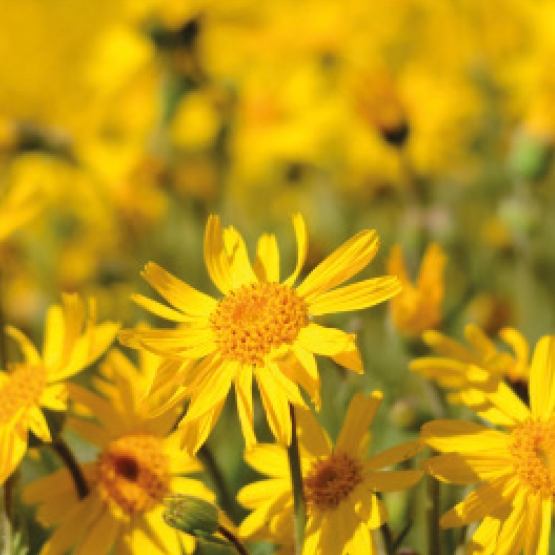
For hemorrhoids
GSE
Because of its outstanding antibacterial, antifungal and antiparasitic properties, combined with its selectivity, Grapefruit Seed Extract is indispensable for correcting intestinal dysbiosis that is typical of hemorrhoid sufferers. Recent studies have also highlighted the cytoprotective capabilities of GSE due to its inhibition of the production of pro-inflammatory mediators and the consequent protection of the integrity of epithelial tissues.
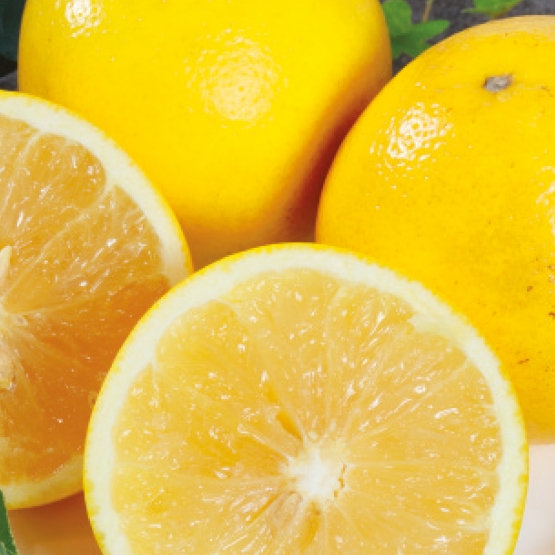
GSEvolved®
GSE's action has been enhanced through an innovative technology resulting in GSEvolved®: GSE combined with hyperfermented GSE. Thanks to its extraordinary broad-spectrum microbial properties, GSE is indispensable in the treatment of hemorrhoids, especially in cases of bleeding, as a natural sanitizer, acting in full respect of the physiology of the anal area.
CUTTING-EDGE NATURE: HYPERFERMENTATION OF GRAPEFRUIT SEEDS
Using a patented production process, which combines molecular enzymatic bioliquefaction with fermentation, all parts of the seeds (even those low in sugars) are made fermentable. The patented process is called "hyperfermentation."
Bioliquefaction, through a combination of multiple enzymatic treatments, extracts 100% of the molecules that make up the plant's phytocomplex and turns it into an active, bioavailable form. This technology makes it possible to obtain phytocomplexes that are rich in active ingredients, extremely complete and bioavailable, and consequently highly effective.
Fermentation converts enzymatically hydrolyzed inert fiber into additional active ingredients (antioxidants, vitamins, proteins, amino acids) and converts it into saccharides.
The combination of these two methods releases the mono- and oligosaccharides in the seeds and enhances the plant phytocomplex by increasing:
- SOLUBLE POLYPHENOL CONTENT BY 120%
- THE ANTIOXIDANT POWER BY 240%
- THE AMINO ACID/PROTEIN FRACTION BY 29 TIMES
- CONCENTRATION OF SOLUBLE FLAVONOIDS BY 12%
CYPRESS
Due to their antiseptic, astringent and antioxidant properties, cypress cones are used for internal use to treat inflammatory conditions, such as hemorrhoids. They are also recognized for their antibacterial effects against Gram-positive and Gram-negative bacteria and yeasts. An Cypress cone extract was developed specifically for our product, through an ultrasonic extraction process that allows the release of all the active ingredients contained in the plant without the use of heat or solvents.
BLACKCURRANT
Blackcurrant juice has demonstrated good antioxidant properties, mainly attributed to its Vitamin C and flavonoid (flavonols, anthocyanins and tannins) content. The phytocomplex has an anti-inflammatory effect and supports microcirculation, providing benefits for problems associated with venous insufficiency and hemorrhoids.
MARSHMALLOW POLYSACCHARIDES
Marshmallow, a plant rich in mucilaginous polysaccharides, is traditionally used to treat irritated mucous membranes. Due to their ability to form a thin layer over the mucosa, Marshmallow polysaccharides can protect the tissue from chemical-physical and microbial stress. In addition, Marshmallow extract has an anti-inflammatory and antioxidant effect.
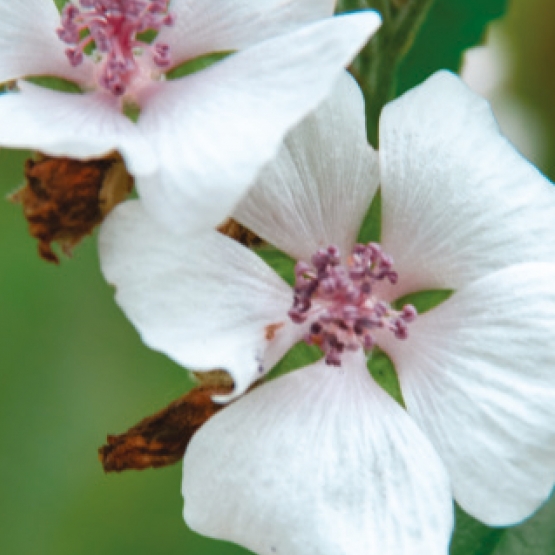
MYRTLE POLYSACCHARIDES
Myrtle leaf extracts, rich in Polysaccharides, can improve cell renewal, skin hydration and provide relief. They improve hydration and support the skin's barrier function.
OPUNTIA POLYSACCHARIDES
Polysaccharides extracted from Opuntia have excellent barrier and moisturizing properties. Opuntia can protect tissues from cellular oxidative stress and accelerate epithelial regeneration, as well as having good anti-inflammatory properties.
VITAMIN E (TOCOPHEROL)
Tocopherol, the Vitamin E homologue with greater biological activity, is generally considered the most important fat-soluble antioxidant in human tissues. Clinical practice in dermatology shows that it benefits inflammation-based skin diseases. This oil has a significant moisturizing effect and minimizes transepidermal water loss, as well as antioxidant capacity.
TAMANU OIL
Tamanu oil has been scientifically proven to have excellent anti-inflammatory properties. A prized remedy for its antioxidant and cytoprotective action, it has been shown to protect the skin from oxidative stress. When used within an emulsion, it promotes collagen production and wound repair. Finally, it is effective in treating skin infections due to its potent antibacterial effect.
EPSOM SALTS
Epsom salts (Magnesium Sulfate or Bitter Salt) are colorless crystals originating in the British town of Epsom, from which they take their name. They are traditionally used to treat various skin conditions and to make sitz baths for anorectal conditions. Their efficacy is mainly due to the presence of magnesium ions, which can permeate the skin, increasing its hydration, reducing muscle tension, and having an analgesic effect. Sulfur also has a beneficial anti-inflammatory, keratoplastic and anti-itching effect. Sulfur water is also associated with antibacterial and antifungal properties.
Epsom Salt increases water density, allowing the submerged areas to float and be less affected by the force of gravity, thus promoting lymphatic and venous circulation. Sitz baths performed with warm water facilitate the reduction of rectal and anal sphincter pressure.
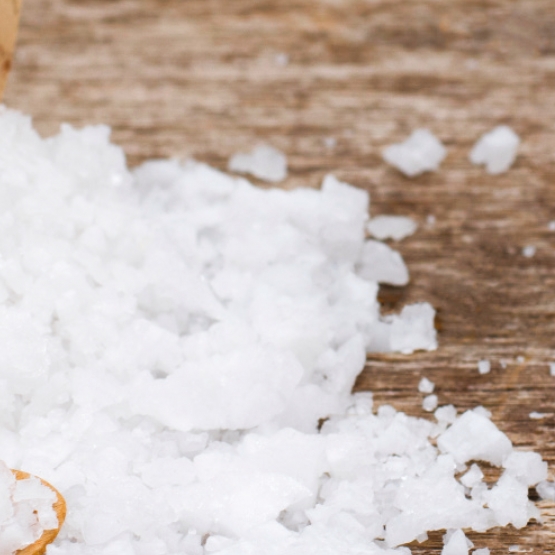
LIFESTYLE – VENOUS SYSTEM NUTRITION
Taking care of venous system health means acting on several fronts, and diet is one of the pillars that can restore lightness to the legs and relief in cases of hemorrhoids before the more serious clinical complaints of venous insufficiency set in. This, together with adequate physical activity and the appropriate use of supplements. The first step is to reduce salt from the diet because excess salt stiffens the walls of the venous system and carries water outside the cells, causing water retention, a typical symptom accompanying venous insufficiency. Along with the limited but conscious consumption of salt, it is essential to hydrate adequately and to adopt a varied, balanced diet rich in foods that are a source of valuable vitamins, minerals and antioxidants, useful in aiding the function of the cardiovascular system as well as preventing venous insufficiency.
WHAT TO DO IN PRACTICE?
- Reduce sodium intake and sodium-rich foods. The most sodium-rich food is table salt, followed by all cured meats, salted foods such as salted meat and fish, soy sauce, capers, sun-dried tomatoes, cheese, pickled olives, salted popcorn, saltine crackers, etc.
PRACTICAL ADVICE: To limit salt consumption, use a teaspoon to measure it. We recommend getting used to seasoning dishes with the teaspoon and putting in a pinch of salt less every week; this strategy will train the palate to feel less of a need for it. IMPORTANT: use unrefined salt. - Increase your consumption of plant foods that contain flavonoids, antioxidant elements with known beneficial effects on the vein walls. Favor citrus fruits, apples, cherries, grapes, strawberries, cabbage, broccoli, onions, etc. For those with a sweet tooth for chocolate, there is good news: dark chocolate, at above 75 percent cocoa, provides considerable amounts of flavonoids. It is important not to abuse it and to choose quality dark chocolate with no added sugars.
- Get into the habit of drinking orange juice with lemons. The vitamin C and citric acid in these foods strengthen tissues, hindering skin damage. Blueberries, blackberries, strawberries, cherries, tomatoes, kiwi, parsley, kale, and salad are also foods that are rich in vitamin C.
- If hemorrhoids are present, avoid fermented cheeses such as gorgonzola, spicy foods, cold cuts and sausages, fried foods, pickles, spices, coffee, alcoholic beverages (wine, beer). If the problem is frequent or prolonged, it is a good idea to consult your doctor to rule out any other issues
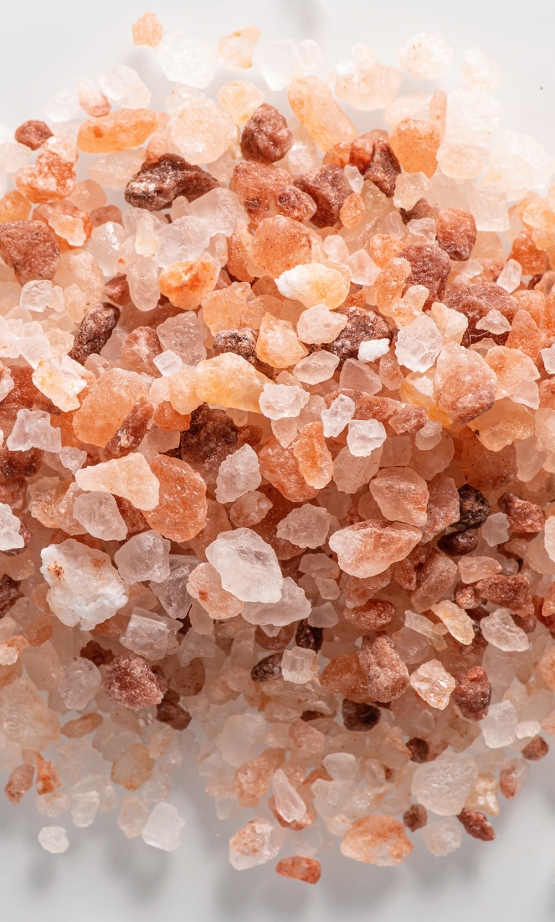
THE BENEFITS OF
- WHOLE GRAIN CEREALS, PSEUDOCEREALS, FRUITS AND VEGETABLES. Chronic constipation, which hinders the return of venous blood towards the upper body, can be identified as a contributing factor in venous insufficiency. The daily, conscious consumption of plant fiber allows for the blood to flow more easily, thus preventing blood reflux in the lower limbs while improving bowel function. Fiber is divided into soluble fiber and insoluble fiber: soluble fiber, contained in apples, oranges, and vegetables in general, absorbs and retains water, promoting the hydration of the fecal mass and intestinal peristalsis; insoluble fiber, contained mainly in the bran of whole grains and legumes, acts by producing a mechanical entrainment effect. Additional foods that regularize the bowel, making bowel movements easier due to their richness in mucilage, include: flaxseed, psyllium seeds, oats and barley. These are also particularly useful additions for those who are prone to hemorrhoids.
- EGGS, CARROTS, DARK GREEN LEAFY VEGETABLES. Vitamin A (retinol - found in eggs) and the carotenoids abundant in plants are powerful antioxidants that can protect cells in the venous system from attack by free radicals that induce oxidative stress, one of the causes of inflammation and the stiffening of cell membranes.
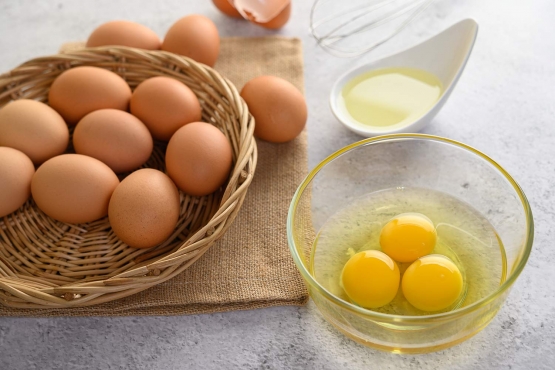
- LEGUMES, MEAT (PREFERABLY WHITE MEAT), FISH, EGGS. The B vitamins in these foods help to prevent vascular damage caused by homocysteine. Homocysteine is a cytotoxin which, at high concentrations, can alter the functioning of vascular cells and promote the development of thrombi. Increased homocysteine levels can be caused by a deficiency of vitamin B6, vitamin B12, and vitamin B9 (folic acid). To degrade this cytotoxin into harmless substances, the body requires B-group vitamins, which are specifically recommended in cases of increased homocysteine values and chronic venous insufficiency.
- consuming foods of organic and/or 0-km origin
- following a varied diet, favoring the consumption of fruits and vegetables, preferably in season, easily digestible proteins (fresh small fish, white meat, eggs), legumes, pumpkin seeds, sunflower, flax, chia, etc., walnuts, almonds, hazelnuts, etc.
- consuming cereals, preferably whole grain but not only, because in some cases fiber prevents the absorption of minerals and other nutrients, semi-wholegrain cereals and pseudocereals (quinoa, buckwheat, amaranth)
- preferring foods that are sources of omega-3 fatty acids, such as flax oil, hemp oil, oily fish (mackerel, sardines, sardines etc.), chia seeds, flax seeds, etc.
- staying adequately hydrated. Water requirements vary from individual to individual and change according to different lifestyles, the type of activity and the diet. An adult should generally drink 2 liters of water per day for maintaining their health. Water is an essential element for the body because it regulates various biological functions. Therefore, it is important to maintain proper hydration, especially during the summer season, during sports activities and in all situations where a lot of fluids are lost.
- avoiding abuse of gluten-containing foods, packaged foods and fried foods
- limiting sugar, sugary drinks, refined grains (white bread, white pasta, white rice, etc.)
avoiding hydrogenated fats, limiting red meat, milk and its derivatives, and salt. When consuming them, prefer those of high quality
The notions and advice offered herein are for educational purposes only and cannot under any circumstances replace medical advice. For a complete diet, it is necessary to consult a nutritionist, who, after appropriate clinical and instrumental examination, will be able to identify the needs of the person concerned and put together a personalized diet plan.
